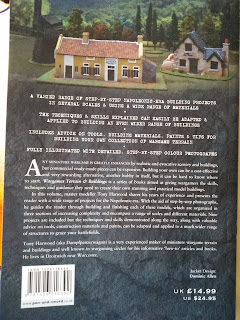 Il libro di oggi è un libro estremamente tecnico ma di facile fruizione. Chi ha provato a costruire un diorama, che fosse per i suoi wargames con le miniature o che fosse un semplice diorama da esposizione si è sempre trovato un po' perso tra materiali, tecniche e risultati che non davano molta soddisfazione. E' capitato a tutti gli appassionati. Questo libro, incentrato sugli edifici tipici (e iconici!) delle Guerre Napoleoniche da' una grande mano d'aiuto. Scritto da Tony Harwood ed edito da Pen&Sword History, questo bel manuale fotografico ci porta attraverso la costruzione di una serie di edifici del periodo napoleonico. Quindi prettamente rurali. Le scale dei modelli sono varie, ma sono tutte le scale tipiche usate per i Wargames: 15mm, 20mm, 28/30mm.
Il libro di oggi è un libro estremamente tecnico ma di facile fruizione. Chi ha provato a costruire un diorama, che fosse per i suoi wargames con le miniature o che fosse un semplice diorama da esposizione si è sempre trovato un po' perso tra materiali, tecniche e risultati che non davano molta soddisfazione. E' capitato a tutti gli appassionati. Questo libro, incentrato sugli edifici tipici (e iconici!) delle Guerre Napoleoniche da' una grande mano d'aiuto. Scritto da Tony Harwood ed edito da Pen&Sword History, questo bel manuale fotografico ci porta attraverso la costruzione di una serie di edifici del periodo napoleonico. Quindi prettamente rurali. Le scale dei modelli sono varie, ma sono tutte le scale tipiche usate per i Wargames: 15mm, 20mm, 28/30mm.Abbiamo una serie di costruzioni che sono illustrate passo passo nella loro realizzazione, questa è la lista:
Mulino Russo 15mm
Casa a due piani Francese 28/30mm
La Belle Alliance 20mm
Piccionaia Francese 28/30mm
Pozzo in pietra 28/30mm
Granaio Russo 28/30mm
Piccolo forno Tedesco 28/30mm
Cappella Ungherese 28/30mm
Diorama Peninsulare 28/30mm
Come si può vedere vengono dapprima analizzate diverse scale, per poi assestarsi sulla più tipica scala 28/30mm. La guida, come illustrato nelle fotografie, è passo passo. Siamo guidati attraverso la scelta dei materiali (molto semplici, niente di elaborato o costoso) e la realizzazione. Un particolare riguardo è dato alla pittura dei piccoli edifici che contribuisce alla credibilità dell'opera finita.
Alla fine di ogni sezione vi è un elenco dei materiali usati e dei colori. Alla fine del libro è presente un glossario per orientarsi in mezzo a termini un po' più tecnici.
Che dire di questo libro? E' secondo me un must per chiunque voglia sperimentare la costruzione di piccoli edifici, anche se non è un wargamer. Per conto mio, la tentazione di costruire la Cappella Ungherese o la più impegnativa Belle Alliance (ovvero la fattoria dove si incontrarono dopo la Battaglia di Waterloo il Maresciallo Blucher e il Duca di Wellington) è molto forte. Il risultato finale forse non sarà come quello di questo bellissimo libro ma sono sicuro che provando qualcosa verrà fuori.
Un altro bellissimo libro da parte di Pen&Sword!
Un grazie di cuore a tutto lo staff per avermi fornito questo interessante libro!
Titolo: Wargames Terrain & Buildings - The Napoleonic Wars
Autore:Tony Harwood
Pagine: 160
Link: https://www.pen-and-sword.co.uk/Wargames-Terrain-and-Buildings-Paperback/p/15335
















Thank you for the informative review.
ReplyDeleteTony Harwood
Thanks to you for the beautiful book!
DeleteHere you can find the translation of the review:
Deletehttps://www.facebook.com/search/top/?q=On%20the%20Old%20Barbed%20Wire%20napoleonic&epa=SEARCH_BOX
Wargames Terrain & Buildings - The Napoleonic Wars by Tony Harwood
Today's book is an extremely technical but easy to use book. Those who tried to build a diorama, which was for its wargames with miniatures or was a simple display diorama, always found itself a bit lost among materials, techniques and results that did not give much satisfaction. It happened to all the modellers (or better newbies). This book, focused on the typical (and iconic!) buildings of the Napoleonic Wars gives a great helping hand. Written by Tony Harwood and published by Pen & Sword History, this beautiful photographic manual takes us through the construction of a series of buildings from the Napoleonic period. So they are mainly rural. The scales of the models are various, but they are all the typical scales used for the Wargames: 15mm, 20mm, 28 / 30mm.
We have a series of constructions that are illustrated step by step in their realization, this is the list:
Russian Windmill15mm
French two-storey house 28 / 30mm
La Belle Alliance 20mm
French Pigeonnier 28 / 30mm
Stone built well 28 / 30mm
Russian Granary 28 / 30mm
Small German oven 28 / 30mm
Hungarian Chapel 28 / 30mm
Peninsular Diorama 28 / 30mm
As you can see, various scales are first analyzed and then the author settles on the most typical 28 / 30mm scale. The guide, as shown in the photographs, is step by step. We are guided through the choice of materials (very simple, nothing elaborate or expensive) and the realization. Particular attention is given to the painting of small buildings which contributes to the credibility of the finished work.
At the end of each section there is a list of the materials used and the colors. At the end of the book there is a glossary to guide you in the midst of somewhat more technical terms.
What about this book? In my opinion it is a must for anyone who wants to experiment with the construction of small buildings, even if it is not a wargamer. For my part, the temptation to build the Hungarian Chapel or the more demanding Belle Alliance (the farm where Marshal Blucher and the Duke of Wellington met after the Battle of Waterloo) is very strong. The end result may not be like that of this beautiful book but I'm sure that by trying something will come out.
Another beautiful book by Pen & Sword!
A heartfelt thanks to all the staff for providing me with this interesting book!
Title: Wargames Terrain & Buildings - The Napoleonic Wars
Author:Tony Harwood
Pages: 160